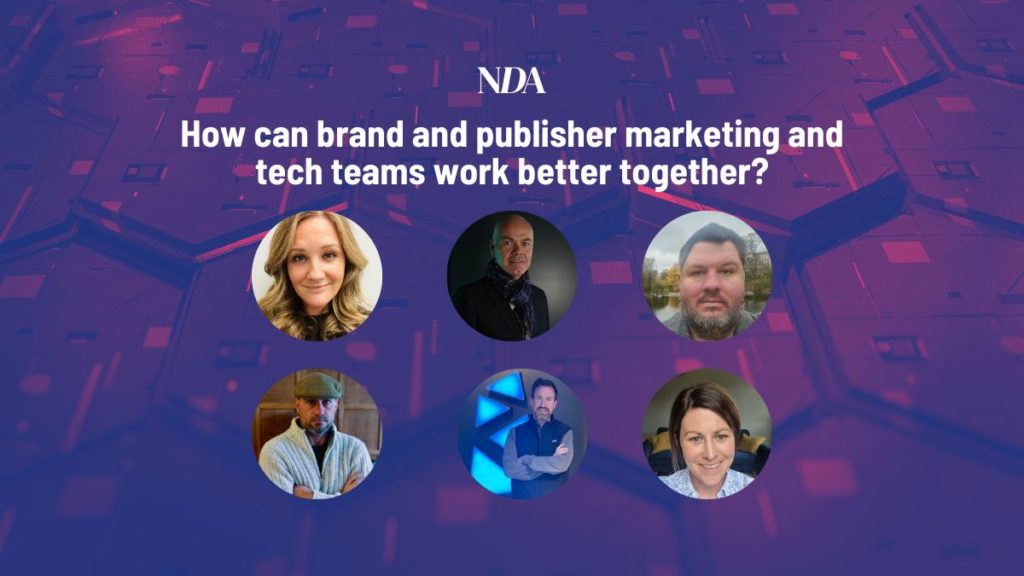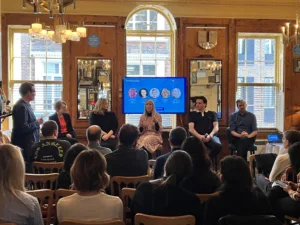It might sound strange for two sides that are diametrically opposed, but when it comes to data, advertisers and publishers are more aligned than ever.
No, it’s not necessarily a new claim. Go back to the emergence of the General Data Protection Regulation for that. But it is a claim that has a lot more weight to it these days. NDA brought together a range of experts to discuss how advertisers and publishers’ marketing and technology teams were finding ways to work together more closely.
That was abundantly clear in the first part of our roundtable, in partnership with CvE, where our panel of experts talked about data strategies that were less predicated on replicating third-party cookies — as has arguably been the case up until now — and more about moving away from them entirely. What matters to these execs now is privacy-first solutions that connect advertisers with publishers through content at the right moment.
Chaired by NDA’s editor Justin Pearse, the roundtable featured Matthew Lawson, Chief Digital Officer at Ribble Cycles; Peter Barr Watson, Chief Technical Officer and Director of Digital at The Spectator; Rob Webster, VP of Strategy at CvE; Ulrich Gilot, Head of Media for Global Marketing at Betsson Group; Jim Meadows, Director of Influencer, Media and Partnerships at THG; Katrina Broster, Marketing Performance and Technology Director at the Financial Times; and Cat Daniel, Growth Marketing Director at Monzo Bank.
“There’s no perfect solution to data management,” said CvE’s Webster. “But if you’re aware of the problems then you’re able to handle the situation better, whether that’s adapt technologies or the strategies behind them.”
As ever with anything as complex as data management the devil is in the details. So while there was a unanimous agreement among the speakers that the smart use of technology and data is as important as smart media buying, they’re all pursuing those goals in different ways, and at various stages on that journey.
The Spectator, for example, is easing its way into data management, taking a slow and steady approach to exerting more control over how its audiences are monetized. In other words, the publisher is open to all manner of opportunities at the moment. It’s not ready to take any big gambles on specific solutions or technologies just yet.
As Barr Watson explained: “We’re at the earlier stages in our journey where we’ve stood up a data lake and are now working through the various ways to expose the data we’re capturing to our internal teams, whether that’s revisions of clean rooms for our commercial teams or helping to guide our subscription journeys on the site.”
While the Financial Times is further along in this journey compared to The Spectator, both are treating data like an asset.
“We’ve spent the last few months thinking about how we can evolve our registration strategy to get to a position where we have more zero-party data, which is intrinsically privacy-first,” said Broster.
The zero-party data in question is essentially information someone intentionally shares with a brand in exchange for something that might improve their experience with said company. Get this sort of data right and a publisher like the Financial Times stands to sharpen the audiences it sells to advertisers and improves marketing scale and efficiency. For starters, volunteered data like zero-first party is more accurate than the so-called inferred data that usually takes up the bulk of first-party data sets.
On the flipside, advertisers like Ribble Cycles are reallocating a greater percentage of their ad budgets to creating mutual and ongoing value exchanges with consumers so they can build their first-party data assets.
“We’re trying to find ways of further leveraging the information that we’re able to gather,” said Lawson. “We are currently using our customer browsing behavior as such by layering machine learning algorithms on top of it to predict whether that customer will look like a purchaser. The importance of doing so is allowing me to get first-party data sets that I can then push out into marketing channels.”
It’s the perennial question for marketers: how to get a better view of the customer in a way that unearths better efficiencies for the business.
“The other real focus for us at The Hut Group is around the handling of data,” said Meadows. “We’re making sure that the data is ready to be used and that we have the right tools to be able to use it in safe haven environments so that we can enrich our data with partner intelligence or from third parties.”
Doing so, however, is easier said than done. Data architecture, processes, and practices are far more complex and time-consuming than they were at the advent of online advertising, so the amount of time it takes to evaluate, decide, prepare, and implement an approach is far longer and more involved than most marketers realize. That’s top of mind for Monzo’s marketers.
“Part of this whole approach isn’t just about the data you decide to collect as a marketer, it’s also about how you intend to mine and consume it,” said Daniel. “We’re using tools like Looker to help us consume marketing performance data and Braze as a customer engagement tool to ensure we are always privacy first. Ultimately, it’s more about how we as a business are thinking more clearly about what the customer would want to see and how data plays a part in giving them the most relevant experience.”
It’s that latter point that resonates with Gilot. He’s thinking about how Betsson Group’s tech stack can be adapted to strike a better balance between the interests of consumers and the data collection practices being used today.
“I’m looking into the tech stack that we currently have in place to not only answer the user experience challenges that we face but to also help us evolve how we buy media, particularly when it comes to driving efficiencies, ” said Gilot. “So much of this will come down to understanding how the data is piped across these different technologies to buy media. That’s not a transparent process, but we have auditors to help us.”
The second part of the writeup of this roundtable will be published later this week.









